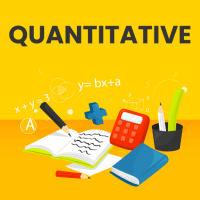Quant Exam > Quant Questions > Three buckets contains balloons filled with w...
Start Learning for Free
Three buckets contains balloons filled with water. First bucket contains 243 balloons. Second contains 304 balloons and last bucket contains 127 balloons. Find the largest number of balloons that can be given equally to the children such that 3, 4 and 7 balloons are left in first, second and third bucket respectively?
- a)20
- b)30
- c)40
- d)60
- e)None of these
Correct answer is option 'D'. Can you explain this answer?
Most Upvoted Answer
Three buckets contains balloons filled with water. First bucket contai...
To find the largest number of balloons that can be given equally to the children, we need to find the greatest common divisor (GCD) of the three numbers: 243, 304, and 127.
Calculating the GCD:
- First, we can find the GCD of 243 and 304. We can use the Euclidean algorithm.
- 304 = 1 * 243 + 61
- 243 = 3 * 61 + 0
- The GCD of 243 and 304 is 61.
- Next, we find the GCD of 61 and 127.
- 127 = 2 * 61 + 5
- 61 = 12 * 5 + 1
- 5 = 5 * 1 + 0
- The GCD of 61 and 127 is 1.
- Finally, we find the GCD of 1 and 7.
- 7 = 7 * 1 + 0
- The GCD of 1 and 7 is 7.
Therefore, the largest number of balloons that can be given equally to the children is the GCD of 243, 304, and 127, which is 7.
Calculating the GCD:
- First, we can find the GCD of 243 and 304. We can use the Euclidean algorithm.
- 304 = 1 * 243 + 61
- 243 = 3 * 61 + 0
- The GCD of 243 and 304 is 61.
- Next, we find the GCD of 61 and 127.
- 127 = 2 * 61 + 5
- 61 = 12 * 5 + 1
- 5 = 5 * 1 + 0
- The GCD of 61 and 127 is 1.
- Finally, we find the GCD of 1 and 7.
- 7 = 7 * 1 + 0
- The GCD of 1 and 7 is 7.
Therefore, the largest number of balloons that can be given equally to the children is the GCD of 243, 304, and 127, which is 7.
Free Test
FREE
| Start Free Test |
Community Answer
Three buckets contains balloons filled with water. First bucket contai...
HCF (240, 300, 120) = 60

|
Explore Courses for Quant exam
|

|
Question Description
Three buckets contains balloons filled with water. First bucket contains 243 balloons. Second contains 304 balloons and last bucket contains 127 balloons. Find the largest number of balloons that can be given equally to the children such that 3, 4 and 7 balloons are left in first, second and third bucket respectively?a)20b)30c)40d)60e)None of theseCorrect answer is option 'D'. Can you explain this answer? for Quant 2025 is part of Quant preparation. The Question and answers have been prepared according to the Quant exam syllabus. Information about Three buckets contains balloons filled with water. First bucket contains 243 balloons. Second contains 304 balloons and last bucket contains 127 balloons. Find the largest number of balloons that can be given equally to the children such that 3, 4 and 7 balloons are left in first, second and third bucket respectively?a)20b)30c)40d)60e)None of theseCorrect answer is option 'D'. Can you explain this answer? covers all topics & solutions for Quant 2025 Exam. Find important definitions, questions, meanings, examples, exercises and tests below for Three buckets contains balloons filled with water. First bucket contains 243 balloons. Second contains 304 balloons and last bucket contains 127 balloons. Find the largest number of balloons that can be given equally to the children such that 3, 4 and 7 balloons are left in first, second and third bucket respectively?a)20b)30c)40d)60e)None of theseCorrect answer is option 'D'. Can you explain this answer?.
Three buckets contains balloons filled with water. First bucket contains 243 balloons. Second contains 304 balloons and last bucket contains 127 balloons. Find the largest number of balloons that can be given equally to the children such that 3, 4 and 7 balloons are left in first, second and third bucket respectively?a)20b)30c)40d)60e)None of theseCorrect answer is option 'D'. Can you explain this answer? for Quant 2025 is part of Quant preparation. The Question and answers have been prepared according to the Quant exam syllabus. Information about Three buckets contains balloons filled with water. First bucket contains 243 balloons. Second contains 304 balloons and last bucket contains 127 balloons. Find the largest number of balloons that can be given equally to the children such that 3, 4 and 7 balloons are left in first, second and third bucket respectively?a)20b)30c)40d)60e)None of theseCorrect answer is option 'D'. Can you explain this answer? covers all topics & solutions for Quant 2025 Exam. Find important definitions, questions, meanings, examples, exercises and tests below for Three buckets contains balloons filled with water. First bucket contains 243 balloons. Second contains 304 balloons and last bucket contains 127 balloons. Find the largest number of balloons that can be given equally to the children such that 3, 4 and 7 balloons are left in first, second and third bucket respectively?a)20b)30c)40d)60e)None of theseCorrect answer is option 'D'. Can you explain this answer?.
Solutions for Three buckets contains balloons filled with water. First bucket contains 243 balloons. Second contains 304 balloons and last bucket contains 127 balloons. Find the largest number of balloons that can be given equally to the children such that 3, 4 and 7 balloons are left in first, second and third bucket respectively?a)20b)30c)40d)60e)None of theseCorrect answer is option 'D'. Can you explain this answer? in English & in Hindi are available as part of our courses for Quant.
Download more important topics, notes, lectures and mock test series for Quant Exam by signing up for free.
Here you can find the meaning of Three buckets contains balloons filled with water. First bucket contains 243 balloons. Second contains 304 balloons and last bucket contains 127 balloons. Find the largest number of balloons that can be given equally to the children such that 3, 4 and 7 balloons are left in first, second and third bucket respectively?a)20b)30c)40d)60e)None of theseCorrect answer is option 'D'. Can you explain this answer? defined & explained in the simplest way possible. Besides giving the explanation of
Three buckets contains balloons filled with water. First bucket contains 243 balloons. Second contains 304 balloons and last bucket contains 127 balloons. Find the largest number of balloons that can be given equally to the children such that 3, 4 and 7 balloons are left in first, second and third bucket respectively?a)20b)30c)40d)60e)None of theseCorrect answer is option 'D'. Can you explain this answer?, a detailed solution for Three buckets contains balloons filled with water. First bucket contains 243 balloons. Second contains 304 balloons and last bucket contains 127 balloons. Find the largest number of balloons that can be given equally to the children such that 3, 4 and 7 balloons are left in first, second and third bucket respectively?a)20b)30c)40d)60e)None of theseCorrect answer is option 'D'. Can you explain this answer? has been provided alongside types of Three buckets contains balloons filled with water. First bucket contains 243 balloons. Second contains 304 balloons and last bucket contains 127 balloons. Find the largest number of balloons that can be given equally to the children such that 3, 4 and 7 balloons are left in first, second and third bucket respectively?a)20b)30c)40d)60e)None of theseCorrect answer is option 'D'. Can you explain this answer? theory, EduRev gives you an
ample number of questions to practice Three buckets contains balloons filled with water. First bucket contains 243 balloons. Second contains 304 balloons and last bucket contains 127 balloons. Find the largest number of balloons that can be given equally to the children such that 3, 4 and 7 balloons are left in first, second and third bucket respectively?a)20b)30c)40d)60e)None of theseCorrect answer is option 'D'. Can you explain this answer? tests, examples and also practice Quant tests.

|
Explore Courses for Quant exam
|

|
Signup for Free!
Signup to see your scores go up within 7 days! Learn & Practice with 1000+ FREE Notes, Videos & Tests.























